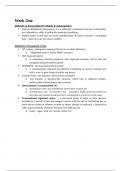Samenvatting
2024-25 Transnational Organised Crime Summary of all Readings and Lectures for exams, Utrecht University
includes detailed discussions on the difficulties in defining and researching organised crime, criminological theories, various crime groups (Italian Mafia, Russian Mafia, Chinese Triads, etc.), the global impact of organised crime, and how legal and illegal spheres interrelate. Key topics cover...
[Meer zien]




